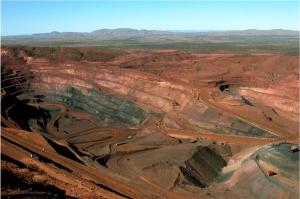Researchers from the University of Tübingen have been able to show for the first time how microorganisms contributed to the formation of the world’s biggest iron ore deposits. The biggest known deposits — in South Africa and Australia — are geological formations billions of years old. They are mainly composed of iron oxides — minerals we know from the rusting process. These iron ores not only make up most of the world demand for iron — the formations also help us to better understand the evolution of the atmosphere and climate, and provide important information on the activity of microorganisms in the early history of life on Earth.
The extent to which microbes in the Earth’s ancient oceans contributed to the formation of iron deposits was previously unknown. Now an international team of researchers from the US, Canada and Germany has published new findings in the journal Nature Communications. Led by University of Tübingen geomicrobiologist Professor Andreas Kappler of the Center for Applied Geoscience, they found evidence of which microbes contributed to the formation of the iron ores, and were able to show how different metabolic processes can be distinguished in the rock formations today.
The iron in the Earth’s ancient oceans was spat out of hot springs on the seafloor as dissolved, reduced ferrous [Fe(II)] iron. But most of today’s iron ore is oxidized, ferric [Fe(III)] iron in the form of “rust minerals” — indicating that the Fe(II) was oxidized as it was deposited. The classic model for the formation of iron deposits suggested that the Fe(II) from the Earth’s core was oxidized by the oxygen produced by cyanobacteria (blue-green algae). This process can happen either chemically (as in the formation of rust) or by the action of microaerophilic iron-oxidizing bacteria.
But scientists are still debating at what point the Earth’s atmosphere contained enough oxygen (produced by cyanobacteria) to allow the formation of big iron deposits. The oldest known iron ores were deposited in the Precambrian period and are up to four billion years old (the Earth itself is estimated to be about 4.6 billion years old). At this very early stage in geological history, there was little or no oxygen in the atmosphere. So the very oldest banded iron formations cannot be the result of O2-dependent oxidation.
In 1993, bacteria were discovered which do not need oxygen but can oxidize Fe(II) by using energy from light (anoxygenic phototrophic iron-oxidizing bacteria). Studies by Professor Kappler’s team in 2005 and 2010 showed that these bacteria transform dissolved ferric iron into iron oxide (rust) — like the material in the early iron ores. Now, the geomicrobiologists from Tübingen have been able to demonstrate that, by examining the identity and structural properties of the iron minerals, it is possible to tell that the minerals were deposited by iron-oxidizing microbes and not by oxygen made available by the action of cyanobacteria. To do this, the researchers placed different amounts of organic material together with iron minerals into gold capsules and increased the pressure and temperature to simulate the transformation of the minerals over geological time. They ended up with structures of iron carbonate minerals (siderite, FeCO3), just as they occur in geological iron formations. In particular, they were able to distinguish iron carbonate structures which had been formed in the presence of a rather small amount of organic compounds (microbial biomass) from those formed in the presence of a larger amount.
This research not only provides the first clear evidence that microorganisms were directly involved in the deposition of Earth’s oldest iron formations; it also indicates that large populations of oxygen-producing cyanobacteria were at work in the shallow areas of the ancient oceans, while deeper water still reached by the light (the photic zone) tended to be populated by anoxyenic or micro-aerophilic iron-oxidizing bacteria which formed the iron deposits.



 April 24th, 2013
April 24th, 2013  Riffin
Riffin 
 Posted in
Posted in  Tags:
Tags: 